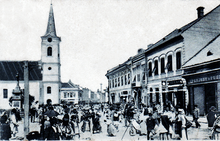Nikolaus Logoschan from Karánsebes
Nikolaus Logoschan von Karánsebes , Romanian Nicolae Lugojanu de Caransebeş (born December 16, 1854 in Caransebeş ; † March 27, 1927 in Sibiu ), was a Romanian-born kuk major general , from 1919 division general in the Romanian army and inventor .
biography
The officer
Nikolaus, the son of the border guard and teacher Dimitrie and his wife Iconia, attended the school for mathematics in Caransebeş, then the military school in Traiskirchen . He finished his training after attending the military academy at the war school in Vienna .
On November 1, 1880 he became a lieutenant in the Hungarian artillery regiment Alois Pichler No. 3 in Komorn and in 1882 took part in the 1882 campaign in Bosnia . On May 1, 1894, he was promoted to captain 1st class in the Archduke Albrecht No. 5 artillery regiment and in 1902 to major in the No. 36 artillery regiment in Sibiu.
In 1903 he served as a lieutenant colonel in the 7th Army Corps and from 1907 was commander of Artillery Regiment No. 19 in Großwardein . In the same post he was promoted to colonel on August 18, 1914 . Already in this early phase of the First World War he had the opportunity to distinguish himself and was awarded the Order of the Iron Crown 3rd class with war decoration . He was already the bearer of the military merit medal "Signum Laudis" on the red ribbon .
Lugojanul was promoted to major general on November 1, 1917 and was raised to the nobility by Emperor Charles I on February 14, 1918 (diploma from April 1 of that year) with the title "von Karánsebes" .
At the beginning of January 1919, the former Austro-Hungarian officer was accepted into the royal Romanian army with the rank of division general and took part in the military operations in Transylvania . He was elected by the border guards to represent the Caransebeş asset company and should become its president after the unification. Since he did not succeed in reaching an agreement between the various political camps, he renounced the candidacy and retired to Sibiu, where he also died. He was buried there by his friend, the military priest Colonel Iosif Serafín from Pătaş ( Caraş-Severin County ).
The inventor
During his time as captain, Lugojanu invented the so-called commodity double key in 1889, with which all doors could be opened at that time. This was patented in Austria-Hungary , Germany , France (patent 201 293 of October 17, 1889) and England .
During his stationing in Pressburg , he applied for a further patent on August 21, 1904, namely that of a technically modified stirrup , the arms of which consist of two articulated parts: The stop of the parts connected to the bridge is limited by stops, which in the Inside the bracket parts are arranged and move within grooves. The patent was granted in Austria-Hungary on July 1, 1905 under the number 22 262.
Individual evidence
- ↑ a b c [1] Druckeria
- ^ Imperial and Royal Military Schematism for 1884, Part 1, KK Hof- und Staatsdruckerei, Vienna, December 1884, pp. 649, 664
- ↑ Schematism for the imperial and royal army and for the imperial and royal navy for 1901, KK Hof- und Staatsdruckerei, Vienna, December 1900, pp. 770, 823
- ↑ War Ministry: "Rankings of the imperial and royal army," KK Court and State Printing House, Vienna 1902, p 7, 27
- ^ [2] Lorenz
- ↑ Book of Honor of the Austro-Hungarian Armed Forces: The Award Winners in World War I, Volume 1, Verlag Vaterländisches Archiv, Vienna 1917, p. 259
- ^ Antonio Schmidt-Brentano: The kk or kuk Generalität 1816–1918, Austrian State Archives, 2007, p. 107
- ↑ Archived copy ( memento of the original from September 23, 2015 in the Internet Archive ) Info: The archive link was inserted automatically and has not yet been checked. Please check the original and archive link according to the instructions and then remove this notice. Ennoblement
- ↑ Bulletin des lois de la République Franc̜aise, vol. 4, Nos. 1302 à 1335, Imprimerie Nationale, Paris 1890, p. 1021
- ↑ Oesterreichisches Patentblatt No. 13, 20, Volume 7, Verlag der Manzschen Hof-, Verlags- und Universitätsbuchhandlung, Vienna 1905, pp. 502, 786
| personal data | |
|---|---|
| SURNAME | Karánsebes, Nikolaus Logoschan from |
| ALTERNATIVE NAMES | Caransebeş, Nicolae Lugojanu de |
| BRIEF DESCRIPTION | Austro-Hungarian major general, then Romanian division general and inventor |
| DATE OF BIRTH | December 16, 1854 |
| PLACE OF BIRTH | Caransebeş |
| DATE OF DEATH | March 27, 1927 |
| Place of death | Sibiu |

